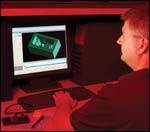Making the Transition to High Performance Machining Techniques
Implementing HPM techniques—such as hard milling—into component production can be straightforward with the correct process and other considerations
To meet the demands of decreasing leadtimes, hard milling mold and die components can be a great way to streamline part production. With today's technologies many parts can be heat treated prior to cutting in a machining center. This will help reduce the need for performing multiple setup operations—ultimately reducing leadtimes and increasing throughput.
HPM Considerations
It is vital to utilize high performance machining (HPM) techniques to maximize part production. Achieving predictable results when cutting hardened material is key to being successful. This can be a very complicated process given the many variables involved; however, implementing hard milling into component production can be straightforward with the correct process and other considerations.
Machine Choice
Using a machine that is specifically designed for HPM will greatly increase the chance for predictable results. A machine built for HPM will have a rigid, low vibration spindle design capable of rpms best suited for the material and cutting tool diameter. It also will have a control capable of accurately controlling machine motion while processing large amounts of program information. The machine will have thermal stability built into a rigid casting. The machine is the foundation for efficient HPM.
Toolholder
In many cases the toolholder is overlooked. A toolholder is the connection of the machine spindle to the part; therefore, it is important to pay close attention to detail when selecting holders. High quality toolholders balanced to maximum rpms is crucial.
Proper care for toolholders also will greatly impact success. Make sure to not transfer tools from machine to machine. Transferring tools can damage a new spindle and will cause fretting. It also is
important to clean the spindle and toolholder. Through proper selection and application, tool life and spindle life will be increased.
Cutting Tools
Cutting tools—whether solid carbide or insert—will vary based on application. Steel grades and cutting tool geometry will determine proper cutter selection. Cutting tool technology changes on a regular basis. Due to the constant changing, it is critical to rely on a high quality tool manufacturer to provide accurate cutting conditions that are based on material type.
Software
CAD/CAM software is the final link in the chain. Using a system designed with HPM in mind will allow for great results. Lead in/lead out control, stock model recognition, custom toolpath creation and the ability to calculate high tolerance tool-paths are essential.
Many programming systems have the ability to recreate proven processes. Provided that the material hardness is the same: programming techniques, cutting tools, speeds and feeds are just a few of the variables that can be reused from job to job. Gouge and collision detection will further maximize spindle uptime to allow for confident unattended operation.
Transitioning to HPM
It also is important to establish a partnership between machine tool manufacturers, software distributors and tooling vendors. This will play a vital role in achieving success through training and continuing support and assist in developing a process to meet specific needs while significantly decreasing the transition into HPM techniques.
Related Content
-
How to Analyze and Optimize Cutting Conditions to Reduce Cycle Time
Plastic injection mold design and manufacturing company puts NC program optimization software module to the test. The results were surprising.
-
How to Produce More Accurate Molds and Reduce Rework
Patented micro-milling process for manufacturing steel plate flat and parallel helps mold builders shorten mold build times and increase accuracy.
-
Developments in High-Speed Machining Technology
There have been many exciting developments in high-speed machining relative to machining centers and controls, tooling and CAD/CAM systems.










.png;maxWidth=300;quality=90)

